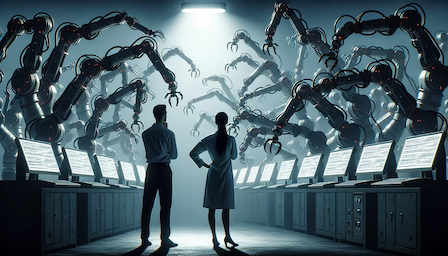
The Unseen Challenges of Ai-generated Text
In March 2023, a group of well-known scientists and business leaders expressed their worries in an open letter. They asked for a pause in the development of AI systems that are more advanced than GPT-4. This highlights how important it is to deal with the risks and consequences that come with AI-created content. A big question we face is: How can we tell the difference between content made by humans and that made by AI?
This is where the field of AI-generated text detection (AGTD) comes in. This new area is getting a lot of attention as researchers and policymakers look for strong ways to spot content made by AI. In this field, a new and important test called the Counter Turing Test (CT2) has been introduced. It aims to thoroughly check how well current AGTD methods work.
The CT2 is more than just a test; it’s a detailed tool made to test how strong AGTD methods are. The first results from this test show that current AGTD methods are not very strong. However, there is hope. The AI Detectability Index (ADI) is a new tool that gives us a way to evaluate and rank Large Language Models (LLMs) based on how easy it is to spot them. The ADI is very important. It could play a big role in making policies related to AI and help the community of Natural Language Processing (NLP) deal with the challenges of AI-created content.
Now, you might be wondering what makes the CT2 and ADI so important. Let’s take a closer look.
The Counter Turing Test (CT2): A Big Change in AI Detection
The CT2 is a beacon of hope in the confusing world of AI-created text. It’s not just about finding small details; it’s about understanding the whole picture. The CT2 aims to show the strong and weak points of AGTD methods, helping researchers and policymakers make better solutions.
The AI Detectability Index (ADI): A New Beginning
The ADI is not just a way to rank things; it’s a groundbreaking tool made to figure out how easy it is to spot content made by LLMs. In a detailed review of 15 modern LLMs, the ADI found that bigger LLMs tend to be harder to spot than smaller ones. This is a key discovery, as it helps us understand the subtle aspects of AI-created content and work on better AGTD methods.
Looking Forward: Challenges and Opportunities
As we move through the tricky world of detecting AI-created text, the CT2 and ADI are essential tools. However, there is still a lot to do. AI is evolving quickly, bringing new challenges. The ongoing battle between creating and detecting AI is intensifying. It’s a back-and-forth game, with both sides constantly changing and adjusting.
The deep discussions about regulating AI and making policies highlight how important it is to have strong AGTD methods. As we find ourselves at a turning point, the CT2 and ADI shine a light on the path forward, pointing us towards a future where we can confidently tell the difference between content made by humans and that made by AI.




